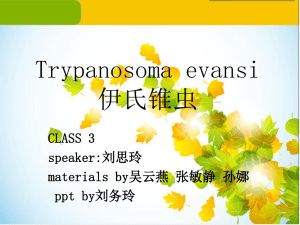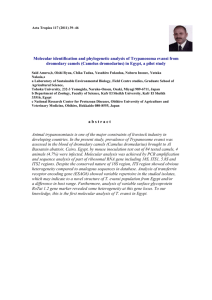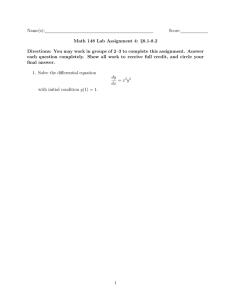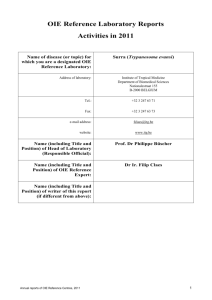Document 12598749
advertisement
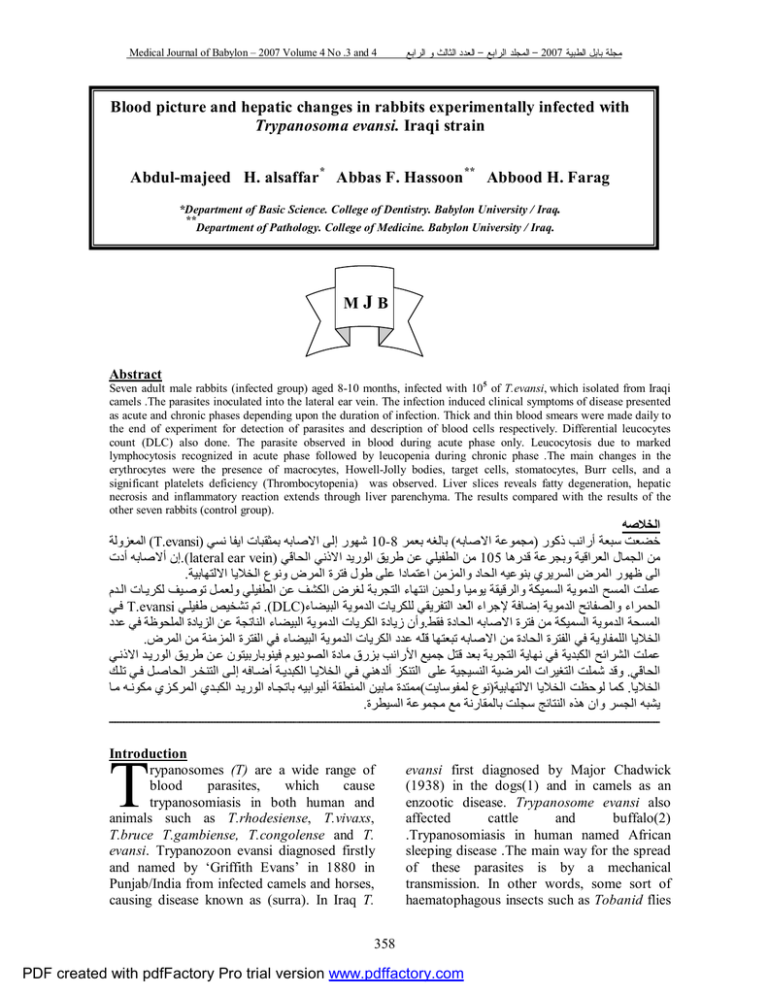
Medical Journal of Babylon – 2007 Volume 4 No .3 and 4 – ﺍﻟﻤﺠﻠﺩ ﺍﻟﺭﺍﺒﻊ – ﺍﻟﻌﺩﺩ ﺍﻟﺜﺎﻟﺙ ﻭ ﺍﻟﺭﺍﺒﻊ2007 ﻤﺠﻠﺔ ﺒﺎﺒل ﺍﻟﻁﺒﻴﺔ Blood picture and hepatic changes in rabbits experimentally infected with Trypanosoma evansi. Iraqi strain Abdul-majeed H. alsaffar* Abbas F. Hassoon** Abbood H. Farag *Department of Basic Science. College of Dentistry. Babylon University / Iraq. ** Department of Pathology. College of Medicine. Babylon University / Iraq. MJB Abstract Seven adult male rabbits (infected group) aged 8-10 months, infected with 105 of T.evansi, which isolated from Iraqi camels .The parasites inoculated into the lateral ear vein. The infection induced clinical symptoms of disease presented as acute and chronic phases depending upon the duration of infection. Thick and thin blood smears were made daily to the end of experiment for detection of parasites and description of blood cells respectively. Differential leucocytes count (DLC) also done. The parasite observed in blood during acute phase only. Leucocytosis due to marked lymphocytosis recognized in acute phase followed by leucopenia during chronic phase .The main changes in the erythrocytes were the presence of macrocytes, Howell-Jolly bodies, target cells, stomatocytes, Burr cells, and a significant platelets deficiency (Thrombocytopenia) was observed. Liver slices reveals fatty degeneration, hepatic necrosis and inflammatory reaction extends through liver parenchyma. The results compared with the results of the other seven rabbits (control group). اﻟﺨﻼﺻﮫ ( اﻟﻤﻌﺰوﻟﺔT.evansi) ﺷﮭﻮر إﻟﻰ اﻻﺻﺎﺑﮫ ﺑﻤﺜﻘﺒﺎت اﯾﻔﺎ ﻧﺴﻲ10-8 ﺧﻀﻌﺖ ﺳﺒﻌﺔ أراﻧﺐ ذﻛﻮر )ﻣﺠﻤﻮﻋﺔ اﻻﺻﺎﺑﮫ( ﺑﺎﻟﻐﮫ ﺑﻌﻤﺮ إن أﻻﺻﺎﺑﮫ أدت.(lateral ear vein) ﻣﻦ اﻟﻄﻔﯿﻠﻲ ﻋﻦ ﻃﺮﯾﻖ اﻟﻮرﯾﺪ اﻻذﻧﻲ اﻟﺤﺎﻓّﻲ105 ﻣﻦ اﻟﺠﻤﺎل اﻟﻌﺮاﻗﯿﺔ وﺑﺠﺮﻋﺔ ﻗﺪرھﺎ .اﻟﻰ ﻇﮭﻮر اﻟﻤﺮض اﻟﺴﺮﯾﺮي ﺑﻨﻮﻋﯿﮫ اﻟﺤﺎد واﻟﻤﺰﻣﻦ اﻋﺘﻤﺎدا ﻋﻠﻰ ﻃﻮل ﻓﺘﺮة اﻟﻤﺮض وﻧﻮع اﻟﺨﻼﯾﺎ اﻻﻟﺘﮭﺎﺑﯿﺔ ﻋﻤﻠﺖ اﻟﻤﺴﺢ اﻟﺪﻣﻮﯾﺔ اﻟﺴﻤﯿﻜﺔ واﻟﺮﻗﯿﻘﺔ ﯾﻮﻣﯿﺎ وﻟﺤﯿﻦ اﻧﺘﮭﺎء اﻟﺘﺠﺮﺑﺔ ﻟﻐﺮض اﻟﻜﺸﻒ ﻋﻦ اﻟﻄﻔﯿﻠﻲ وﻟﻌﻤ ﻞ ﺗﻮﺻ ﯿﻒ ﻟﻜﺮﯾ ﺎت اﻟ ﺪم ﻓ ﻲT.evansi ﺗﻢ ﺗﺸﺨﯿﺺ ﻃﻔﯿﻠ ﻲ.(DLC)اﻟﺤﻤﺮاء واﻟﺼﻔﺎﺋﺢ اﻟﺪﻣﻮﯾﺔ إﺿﺎﻓﺔ ﻹﺟﺮاء اﻟّﻌﺪ اﻟﺘﻔﺮﯾﻘﻲ ﻟﻠﻜﺮﯾﺎت اﻟﺪﻣﻮﯾﺔ اﻟﺒﯿﻀﺎء وأن زﯾﺎدة اﻟﻜﺮﯾﺎت اﻟﺪﻣﻮﯾﺔ اﻟﺒﯿﻀﺎء اﻟﻨﺎﺗﺠﺔ ﻋﻦ اﻟﺰﯾﺎدة اﻟﻤﻠﺤﻮﻇﺔ ﻓﻲ ﻋﺪد.اﻟﻤﺴﺤﺔ اﻟﺪﻣﻮﯾﺔ اﻟﺴﻤﯿﻜﺔ ﻣﻦ ﻓﺘﺮة اﻻﺻﺎﺑﮫ اﻟﺤﺎدة ﻓﻘﻂ .اﻟﺨﻼﯾﺎ اﻟﻠﻤﻔﺎوﯾﺔ ﻓﻲ اﻟﻔﺘﺮة اﻟﺤﺎدة ﻣﻦ اﻻﺻﺎﺑﮫ ﺗﺒﻌﺘﮭﺎ ﻗﻠّﮫ ﻋﺪد اﻟﻜﺮﯾﺎت اﻟﺪﻣﻮﯾﺔ اﻟﺒﯿﻀﺎء ﻓﻲ اﻟﻔﺘﺮة اﻟﻤﺰﻣﻨﺔ ﻣﻦ اﻟﻤﺮض ﻋﻤﻠﺖ اﻟﺸﺮاﺋﺢ اﻟﻜﺒﺪﯾﺔ ﻓﻲ ﻧﮭﺎﯾﺔ اﻟﺘﺠﺮﺑﺔ ﺑﻌﺪ ﻗﺘﻞ ﺟﻤﯿﻊ اﻷراﻧﺐ ﺑﺰرق ﻣﺎدة اﻟﺼﻮدﯾﻮم ﻓﯿﻨﻮﺑﺎرﺑﯿﺘﻮن ﻋ ﻦ ﻃﺮﯾ ﻖ اﻟﻮرﯾ ﺪ اﻻذﻧ ﻲ وﻗﺪ ﺷﻤﻠﺖ اﻟﺘﻐﯿﺮات اﻟﻤﺮﺿﯿﺔ اﻟﻨﺴﯿﺠﯿﺔ ﻋﻠﻰ اﻟﺘﻨﻜﺰ أﻟﺪھﻨﻲ ﻓ ﻲ اﻟﺨﻼﯾ ﺎ اﻟﻜﺒﺪﯾ ﺔ أﺿ ﺎﻓﮫ إﻟ ﻰ اﻟﺘﻨﺨ ﺮ اﻟﺤﺎﺻ ﻞ ﻓ ﻲ ﺗﻠ ﻚ.اﻟﺤﺎﻓّﻲ ﻛﻤﺎ ﻟﻮﺣﻈﺖ اﻟﺨﻼﯾﺎ اﻻﻟﺘﮭﺎﺑﯿﺔ)ﻧﻮع ﻟﻤﻔﻮﺳﺎﯾﺖ(ﻣﻤﺘﺪة ﻣﺎﺑﯿﻦ اﻟﻤﻨﻄﻘﺔ أﻟﺒﻮاﺑﯿﮫ ﺑﺎﺗﺠ ﺎه اﻟﻮرﯾ ﺪ اﻟﻜﺒ ﺪي اﻟﻤﺮﻛ ﺰي ﻣﻜﻮﻧ ﮫ ﻣ ﺎ.اﻟﺨﻼﯾﺎ .ﯾﺸﺒﮫ اﻟﺠﺴﺮ وان ھﺬه اﻟﻨﺘﺎﺋﺞ ﺳﺠﻠﺖ ﺑﺎﻟﻤﻘﺎرﻧﺔ ﻣﻊ ﻣﺠﻤﻮﻋﺔ اﻟﺴﯿﻄﺮة ــــــــــــــــــــــــــــــــــــــــــــــــــــــــــــــــــــــــــــــــــــــــــــــــــــــــــــــــــــــــــــــــــــــــــــــــــــــــــــــــــــــــــــــــــــــــــــ Introduction rypanosomes (T) are a wide range of blood parasites, which cause trypanosomiasis in both human and animals such as T.rhodesiense, T.vivaxs, T.bruce T.gambiense, T.congolense and T. evansi. Trypanozoon evansi diagnosed firstly and named by ‘Griffith Evans’ in 1880 in Punjab/India from infected camels and horses, causing disease known as (surra). In Iraq T. T evansi first diagnosed by Major Chadwick (1938) in the dogs(1) and in camels as an enzootic disease. Trypanosome evansi also affected cattle and buffalo(2) .Trypanosomiasis in human named African sleeping disease .The main way for the spread of these parasites is by a mechanical transmission. In other words, some sort of haematophagous insects such as Tobanid flies 358 PDF created with pdfFactory Pro trial version www.pdffactory.com Medical Journal of Babylon – 2007 Volume 4 No .3 and 4 can transfer the infected blood to other healthy organisms. Trypanosome species carried by Tobanid flies, T.evansi remains monomorphic throughout its life cycle, while T. brucei subspecies presents different range of forms during different points of its life cycle(3) . The present study deals with the clinical, some hematological and pathological changes in blood and liver of adult male rabbits experimentally infected with Iraqi strain of T.evansi. Materials and Methods Fourteen adult male rabbits 8-10 months old, of New Zealand white strain used for this experiment. The animals maintained under the same period of daylight and 25ºC temperature; they received adequate green food and water throughout the period of experiment. The rabbits randomly assigned into two groups, each one include seven animals, an infected group and control group. Each rabbit of the infected group received intra-venous injection via the lateral ear vein 10(5)of T.evansi strain that infects Iraqi camels (Camelus dromedaus). Thick and thin blood smears made daily to the end of the sixth week from both groups(4). At the end of experiment all, the rabbits killed by sodium phenobarbitone injection in their lateral ear vein. The liver of both rabbit groups collected, dissected longitudinally and transversely, finally fixed by Bouin's fixative solution(5.6.) The liver pieces washed thoroughly by water, and processed by automatic tissues processor then embedded in paraffin wax .Liver pieces sliced by microtome to about 3-4µ thickness. The slices fixed on glass slides and stained by Harris heamatoxylin-eosin stain(5). All the stained slides examined microscopically to observe pathological changes due to the infection with T.evansi. Blood smears stained by Leishmania stain and examined for detection of parasites, differential leucocytes count (DLC) and morphological changes in the blood cells. – ﺍﻟﻤﺠﻠﺩ ﺍﻟﺭﺍﺒﻊ – ﺍﻟﻌﺩﺩ ﺍﻟﺜﺎﻟﺙ ﻭ ﺍﻟﺭﺍﺒﻊ2007 ﻤﺠﻠﺔ ﺒﺎﺒل ﺍﻟﻁﺒﻴﺔ Clinical signs of infected animals approximately the same during the first three days of early acute stage, rise in temperature, loss of appetite, drop in food consumption, emaciation due to loss of body weight, progressive weakness, dullness, pale mucous membrane, and anemia. While the observed clinical signs, in the chronic stage were rough hair coat, more dullness recumbence, fluctuating pyrexia, some animals with corneal opacity and blindness, and these signs continue to the end of experiment. Trypanosomes detected in the blood smears made from the infected rabbits group 10-14 days after infection and leucocytosis due to lymphocytosis diagnosed in late acute stage. Weeks later trypanosomes disappears from the blood films (chronic stage),moreover these smears still show anisocytosis and pokilocytosis and the leucopenia was the predominant feature in this phase .The main morphological changes in erythrocytes were the presence of Howell-Jolly bodies(inclusion bodies),hypochromic cells (Fig.1) stomatocytes and great deficiency or disappeaence of platelets (Fig.2). Burr cells, target cells, macrocytes, and microcytes also observed in blood smears examination (Fig.3). Histological changes in liver of infected group revealed fatty changes, Progressive destruction of hepatic parenchyma, and the inflammatory reaction extended from the portal tract to the parenchyma causing hepatic necrosis. The bridging formation between portal area and central area was observed. These results compared with the liver of control group. Discussion The observed clinical signs on rabbits of this study include rise in temperature during the first three days after infection, loss of appetite, progressive emaciation, and refusal to walk due to recumbence, depression, conjunctivitis, corneal opacity, and anemia in most of the infected rabbits. Dargantes et.al (7)denoted these signs in goats, even these Results 359 PDF created with pdfFactory Pro trial version www.pdffactory.com Medical Journal of Babylon – 2007 Volume 4 No .3 and 4 changes were not pathgnomonic in the absence of parasite in the blood. Audu et.al (8) recognized the same signs in sheep. Damayanti et.al (9) reported them in Indonesian buffalo infected with T.evansi. Silva et.al(10) observed these symptoms in Brazelian Pantanal due to T. vivax infection. Anemia was the most distinct feature of disease (8), in most of experimental animals and it varied from moderate to more intensive anemia. Herrera et.al (11) and Masaka (12) observed anemia in goats and cattle infected with T.vivax. Trypanosoma evansi produces parasitemic waves observed three days post inoculation in rabbits. The parasite was detected in the blood films during daily routine examination of infected blood films (acute phase). More than two weeks later, the trypanosomes disappear from the blood (chronic phase). In sheep infected with T.evansi were also positive for parasite, during the prepatent period which varied between 36 days, and two distinct forms of disease were produced in sheep namely acute (4-14 days post infection) and chronic (43-59 days), the fluctuating pyrexia coincided with rise in parasitemia, these observation declared by Audu et.al (8). The parasite also detected in goats during parasitemia (7). Only Herrera et.al(11) observed that parasitemia extends to the end of experimental period, on coati of South America infected with T.evansi infection. Significant increase in total number of leucocytes observed in acute phase of infection because of lymphocytosis. Lymphopenia in chronic phase. These results coincide with other findings of experiments done previously in buffalo calves, bovine (13.10) sheep (14) ewes(15 )and rabbits (1)6 infected with T.evansi, T.vivax, T.evansi, and T.bruci and T.b gambiense respectively. Another experiment on goat proved opposite the mentioned results and informed that leucocytosis was not a reliable indicator of infection(7). In camels(17 )diagnosed a significant decrease in lymphocyte with a visible increase in both leucocytes and neutrophils noted. In other experimental infection on Norwegian lemming with – ﺍﻟﻤﺠﻠﺩ ﺍﻟﺭﺍﺒﻊ – ﺍﻟﻌﺩﺩ ﺍﻟﺜﺎﻟﺙ ﻭ ﺍﻟﺭﺍﺒﻊ2007 ﻤﺠﻠﺔ ﺒﺎﺒل ﺍﻟﻁﺒﻴﺔ T.lemmi the leucocyte, counts remained the same(18). Morphological changes of erythrocytes showed the presence of anisocytosis, pokilocytosis, target cells, macrocytes, Howell-Jolly bodies, Burr cells, stomatocytes, as well as deficiency in hemoglobin of erythrocytes that usually hypochromic .These changes occurred due to liver disease. The deficiencies of essential elements such as ferrous, vitamin B12 and folates resulting from loss of appetite. While the Presence of Burr cell was an indicator of renal failure. In any way, many of the experimental results mentioned that a significant decrease in hemoglobin percentage and the total erythrocyte count was under its normal level (8.9.11.13.15. )The presence of macrocytes confirmed by many results observed by Silva et.al(10) Ogunsanmi et.al(15) andWiqer(18). They supported our results, and denoted that the presence of macrocytic hypochromic cells in acute stage, and normocytic hypochromic cells in chronic stage(19), but this note excepted by Emeribe(16) where he mentioned that the macrocytic cells shifted terminally to microcyic hypochromic cells with the evidence of a moderate anisocytosis and pokilocytosis of erythrocytes. Hepatic changes may occur due to trypanosomes infection or their products Biswas et.al (20) observed predominant histopathological changes such as pseudolobule formation, necrosis, and hemorrhage within the sinusoids of the liver, and fatty degeneration in hepatic cells of bandicoot rat infected with T.evansi.The changes were destructive and irreversible. Hepatomegaly seen by Dargantes et.al (21) and Damayanti et.al (9) noticed congestion in liver after necropsy in goat and buffalo respectively infected with T.evansi. Necrotic foci in liver and destruction of hepatocytes with infiltration by inflammatory cells in the liver of goats observed by Ngeranwa et.al (22) Losos and Ikede(23) reported that T.bruci localized in the connective tissues of dermis and sub cutis of ears, lips, nose, eyelids and the connective tissues of the nasal mucous membranes in the rabbit. 360 PDF created with pdfFactory Pro trial version www.pdffactory.com Medical Journal of Babylon – 2007 Volume 4 No .3 and 4 References 1. Hoare, C.A. (1956). Morphology and Taxonomic Studies on Mammalian Trypanosomes. VIII. Revision of Trypanosoma evansi. Parasitology. 46. 130-172 2. Leiper J.W.G., (1956).Report to the Government of Iraq on animal parasites and their control, F.A.O., No; 610 3. Hoare, C.A. (1972).The Trypanosomes of Mammals, Blackwell Scientific Publications. Oxford. pp.447 4. Dacie J.V and Lewis S.M. (2006). Practical hematology. 10thEd. Churchill Living stone. London, UK. pp 33-36 5. Luna, L.G. (1968). Manual of histological staining method of the Armed forces. Institute of rd Pathology.3 Ed. McGraw-Hill book Company. New York. 6. Humason, G.L. (1967). Animal tissue techniques. W. H. Freeman and Company. San Francisco. USA 7. Dargantes AP. Reid SA. Copman DB. (2005). Experimental Trypanosoma evansi infection in the goat. I. Clinical signs and clinical pathology. J Comp Pathol. 133(4):261-266. 8. Audu, PA. Esievo KA. Mohammed G. Ajanusi OJ. (1999). Studies of Infectivity and pathogenicity of an isolate of Trypanosoma evansi in Yankasa sheep. Vet Parasitol. 1; 86(30): 185-90. 9. Damayanti R. Graydon RJ. Ladds PW. (1994).The pathology of experimental Trypanosoma evansi infection in the Indonesian buffalo (Bubalus bubalis).J Comp Pathol. 110(3): 237-52 10. Silva RA. Ramirez L. Souza SS. Ortiz AG. Pereira SR. Davila AM. (1999). Hematology of natural bovine trypanosomsis in the Brazilian Pantanal and Bolivian Wetlands. Vet Parasitol. 16; 85(1):87-93 11. Herrera HM. Alessi AC. Marques LC. Santana AE. Aquino LP. Menezes RE. – ﺍﻟﻤﺠﻠﺩ ﺍﻟﺭﺍﺒﻊ – ﺍﻟﻌﺩﺩ ﺍﻟﺜﺎﻟﺙ ﻭ ﺍﻟﺭﺍﺒﻊ2007 ﻤﺠﻠﺔ ﺒﺎﺒل ﺍﻟﻁﺒﻴﺔ 12. 13. 14. 15. 16. 17. 18. 19. Moraes MA. Machado RZ. (2002). Experimental Trypanosome evansi infection in South American coati (Nasua nasua): hematological, biochemical and histopathological changes Acta Trop. 81(3) 203-1 Masaka RA. (1980). The pathogenesis of infection with Trypanosome vivax in goats and cattle. Vet Rec. 13; 107(24):551-7. Hilali M. Abdel-Gawad A. Nassar A. Abdel-Wahab A. (2006). Hematology and biochemical changes in water buffalo calves .Vet Parasitol. 30; 139 (1-3)237-243 Onah DN. Hopkins J. Luckins AG. (1996).Hematological changes in sheep experimentally infected with T.evansi. Parasitol. Res. 82 (8): 65963. Ogunsanmi AO. Akpavie SO. Anosa VO. (1994). Hematological changes in ewes experimentally infected with Trpanosoma bruci. Rev Elev Med Vet Pays Trop. 47(1): 53-7. Emeribe AO and Anosa VO. (1991) .Hematology of experimental Trypanosoma bruci gambiense infection. II. Erythrocyte and leucocyte changes Rev Elev Med Vet Pays Trop. 44 (1):53-57. Choudhary ZI. and Iqbal.J (2000). Incidence, biochemical, and hematological alterations induced by natural trypanosomosis in racing dromedary camels. Acta Trop. 2; 77(2):209-13. Wiqer R. (1978). Hematological, splenic, and adrenal changes associated with natural and experimental infections of Trypanosoma lemmi in Norwegian lemming, Lmmus lemmus (L).Follia Oarasitol (Praha). 25(4):295-301. Goossens B. Osaer S. Kora S. Ndao M. (1998). Hematological changes and antibody response in trypanotolerant sheep and goats following experimental Trpanosoma congolense 361 PDF created with pdfFactory Pro trial version www.pdffactory.com Medical Journal of Babylon – 2007 Volume 4 No .3 and 4 infection. Vet. Parasitol. 27; 79(4):238-97 20. Biswas D. Choudhury A. Misra KK. (2001) .Histopathology of Trypanosoma Trypanozoon evansi infection in bandicoot rat. I. Visceral organs. Exp Parasitol. 99(3):148-59. 21. Dargantes AP. Campbell RS. Copeman DB. Reid SA. (2005). Experimental Trypanosoma evansi infection in the goat.II.pathology. J Comp Pathol. 133(4):267-276 – ﺍﻟﻤﺠﻠﺩ ﺍﻟﺭﺍﺒﻊ – ﺍﻟﻌﺩﺩ ﺍﻟﺜﺎﻟﺙ ﻭ ﺍﻟﺭﺍﺒﻊ2007 ﻤﺠﻠﺔ ﺒﺎﺒل ﺍﻟﻁﺒﻴﺔ 22. Ngeranwa JJ. Gathumbi PK. Mutiga ER. Agumbah GJ. (1993).Pathogenesis of Trypanosoma (bruci) evansi in small east African goats. Res Vet Sci. 54 (3):283-9. 23. Losos G.J. and Ikede, B.O. (1970). Pathology of Experimental trypanosomiasis I the albino rat, rabbit, goat and sheep a preliminary report. Canad. Comp. Med. 34, 209. 362 PDF created with pdfFactory Pro trial version www.pdffactory.com Medical Journal of Babylon – 2007 Volume 4 No .3 and 4 – ﺍﻟﻤﺠﻠﺩ ﺍﻟﺭﺍﺒﻊ – ﺍﻟﻌﺩﺩ ﺍﻟﺜﺎﻟﺙ ﻭ ﺍﻟﺭﺍﺒﻊ2007 ﻤﺠﻠﺔ ﺒﺎﺒل ﺍﻟﻁﺒﻴﺔ Figure (1) Blood film: a. Howell-Jolly bodies. b. hypochromic cell Figure (2) Blood film: a. stomatocyte cells b. deficiency or disappearance of platelet Figure (3) Blood film: a. Burr cell. b. target cell. c. macrocyte cell 363 PDF created with pdfFactory Pro trial version www.pdffactory.com Medical Journal of Babylon – 2007 Volume 4 No .3 and 4 – ﺍﻟﻤﺠﻠﺩ ﺍﻟﺭﺍﺒﻊ – ﺍﻟﻌﺩﺩ ﺍﻟﺜﺎﻟﺙ ﻭ ﺍﻟﺭﺍﺒﻊ2007 ﻤﺠﻠﺔ ﺒﺎﺒل ﺍﻟﻁﺒﻴﺔ Figure (4) Liver (40 x) - Fatty change (arrows) - Necrosis of hepatocytes - Inflammatory cells in portal area extend Into the liver parenchyma Figure (5) Liver (40 x) - formation of bridge (inflammatory reaction) between portal area and central vein 364 PDF created with pdfFactory Pro trial version www.pdffactory.com
